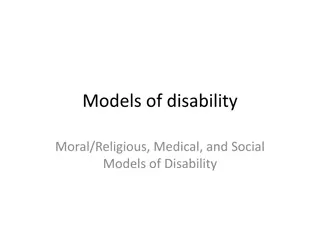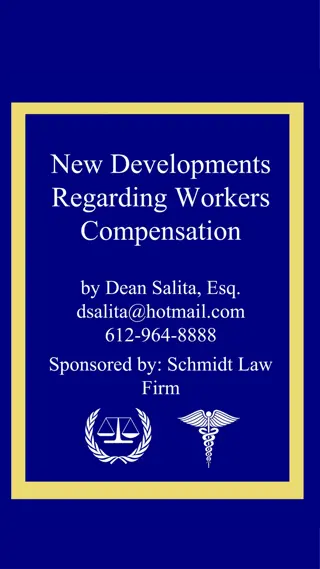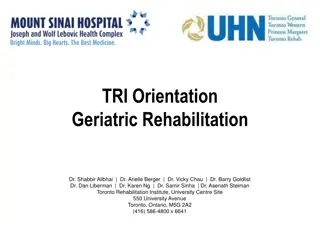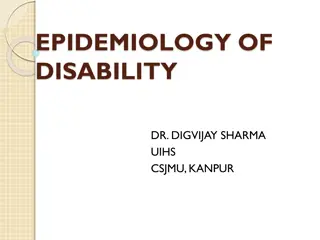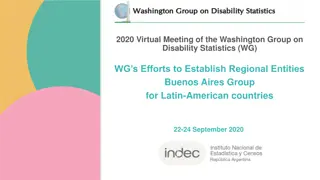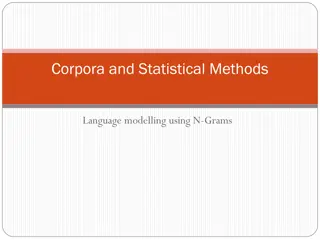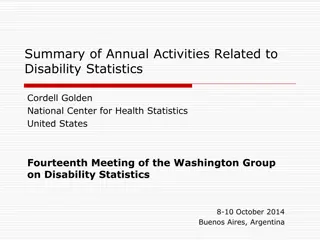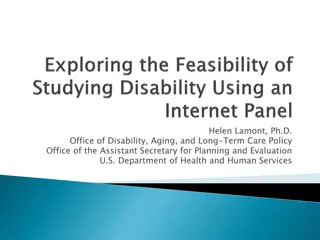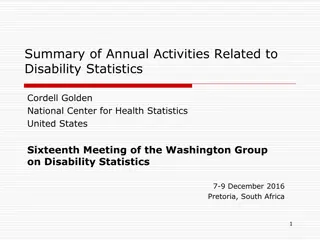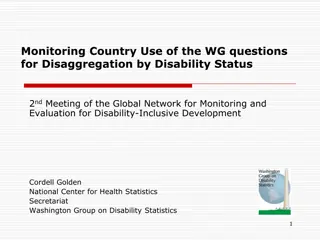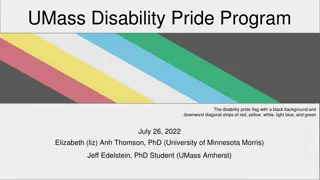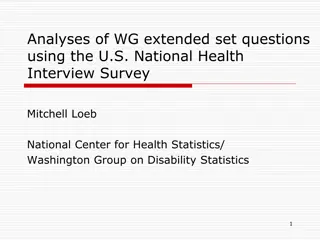Models and Concepts of Disability: Understanding Nagi's Disablement Model
Explore the various models and concepts of disability, including Nagi's Disablement Model, which delineates the pathway from pathology to disability. Learn about Nagi's definition of disability, work disability, and factors influencing the disablement process. Gain insights into impairments, functional limitations, and the social context of disability.
Download Presentation

Please find below an Image/Link to download the presentation.
The content on the website is provided AS IS for your information and personal use only. It may not be sold, licensed, or shared on other websites without obtaining consent from the author.If you encounter any issues during the download, it is possible that the publisher has removed the file from their server.
You are allowed to download the files provided on this website for personal or commercial use, subject to the condition that they are used lawfully. All files are the property of their respective owners.
The content on the website is provided AS IS for your information and personal use only. It may not be sold, licensed, or shared on other websites without obtaining consent from the author.
E N D
Presentation Transcript
Models and Concepts of Disability Disablement Models 1
Agenda Concepts of Disability Nagi s Disablement Model Work Disability Verbrugge and Jette (1994) WHO s Definition Conclusion 2
Think Out Loud How would you define disability? What factors should be considered when determining disability? 3
Nagis Definition of Disability Disability is: the expression of a physical or a mental limitation in a social context [2] a gap between a person s capabilities and the demands created by social and physical environments. [2] 4
Nagis Disablement Model 1 Active Pathology interruption of normal cellular processes and efforts of the organism to regain a normal state. Impairment loss or abnormality at the tissue, organ and body system level. Functional Limitation represents restrictions in the basic performance of the person. 5
Nagis Disablement Model 2 Functional Limitations Pathologies Impairments Environment (including accommodations) Disability 6
Work Disability Work disability: when a health condition (physical or mental) limits the ability of a person to perform the tasks of their occupation. [5] The degree of work disability can be reduced through: 1. Improving an individual s capacity 2. Manipulation of the work environment [5] 7
Example: Nagi and Work Disability Same impairment profile Patient 1 Has balance difficulty Patient 2 Has balance difficulty Different work profile Enters a work disability benefits program Enters a work disability benefits program Unemployed Employed 8
Elaboration of the Disablement Model Nagi Disablement Model Verbrugge and Jette (1994) Extended The goal was to attain a full sociomedical model of disablement. [6] Differentiated the main pathways from factors influencing the ongoing disablement process. [6] 9
Extra-Individual Factors Medical care and rehabilitation Medications and other therapeutic regimens External supports Built, Physical and Social Environment Verbrugge and Jette (1994) Functional Limitations Pathologies Impairments Disability Risk Factors (predisposing characteristics: demographic, social, lifestyle and so on) Intra-Individual Factors Lifestyle and behavior changes Psychosocial attributes and coping Activity accommodations 10
Three Variables to Explain Disablement 1 1. Risk factors are predisposing phenomena that are present prior to the onset of the disabling event that can affect the presence or severity of the disablement process 11
Three Variables to Explain Disablement 2 2. Intra-individual factors are those that operate within a person. 3. Extra-individual factors pertain to factors external to the person, including the physical environment as well as the social context. 12
The Five Applied Dimensions 1. Activities of Daily Living (ADL) includes basic mobility and personal care. [6] 2. Instrumental Activities of Daily Living (IADL)- includes the activities necessary for maintaining a dwelling. [6] 13
The Five Applied Dimensions 2 3. Paid and Unpaid Role Activities includes time consuming societal roles of individuals. [6] 4. Social Activities includes social interactions. [6] 5. Leisure Activities includes what one does for fun or relaxation. [6] 14
International Classification of Impairments, Disabilities, and Handicaps (ICIDH) Activity is the nature and extent of functioning at the level of the person (WHO 1980). Handicap is a disadvantage for a given individual, resulting from an impairment or a disability, that limits or prevents the fulfillment of a normal role. (WHO, 1980, p. 29) Precursor to ICF (discussed later) 15
The Need for Universal Language For public health purposes, there is need for reliable and comparable data on the health of populations. Consistent and internationally comparable metrics are needed to study disability data. There is a need to collect data about the levels and types of disability. 16
Conclusion Institute of Medicine model Verbrugge and Jette Nagi WHO/ICIDH Need for Universal Language WHO s ICF Provides Universal Language 17
References Nagi S. Z. (1964). A study in the evaluation of disability and rehabilitation potential concepts, methods and procedures. American journal of public health and the nation's health, 54(9), 1568 1579. https://doi.org/10.2105/ajph.54.9.1568.[1] Nagi, S. Z., & Marsh, J. (1980). Disability, Health Status, and Utilization of Health Services. International Journal of Health Services, 10(4), 657 676. https://doi.org/10.2190/81FB-J0X4-R9EY-06PV.[2] Institute of Medicine. (1991). Disability in America: Toward a National Agenda for Prevention. Washington, DC: The National Academies Press. https://doi.org/10.17226/1579. [3] Martin, L. G., Zimmer, Z., & Hurng, B. S. (2011). Trends in late-life disability in Taiwan, 1989-2007: the roles of education, environment, and technology. Population studies, 65(3), 289 304. https://doi.org/10.1080/00324728.2011.604730. [4] Institute of Medicine and National Research Council. (2000). Survey Measurement of Work Disability: Summary of a Workshop. Washington, DC: The National Academies Press. https://doi.org/10.17226/9787. [5] Verbrugge, L. M., & Jette, A. M. (1994). The disablement process. Social science & medicine (1982), 38(1), 1 14. https://doi.org/10.1016/0277- 9536(94)90294-1. [6] National Academies of Sciences, Engineering, and Medicine; Health and Medicine Division; Board on Health Care Services; Committee on Functional Assessment for Adults with Disabilities, Flaubert, J. L., Spicer, C. M., & Volberding, P. A. (Eds.). (2019). Functional Assessment for Adults with Disabilities. National Academies Press (US). [7] International Classification of Functioning, Disability and Health (ICF). (n.d.). World Health Organization. Retrieved August 26, 2020, from http://www.who.int/classifications/icf/en/. [8] Introduction to the ADA. (n.d.). ADA.gov. Retrieved August 26, 2020, from https://www.ada.gov/ada_intro.htm.[9] ADA Amendments Act of 2008 Frequently Asked Questions. (n.d.). Retrieved August 26, 2020, from https://www.dol.gov/agencies/ofccp/faqs/americans-with-disabilities-act-amendments. [10] World Health Organization (WHO) Logo, Creative Commons License 18




